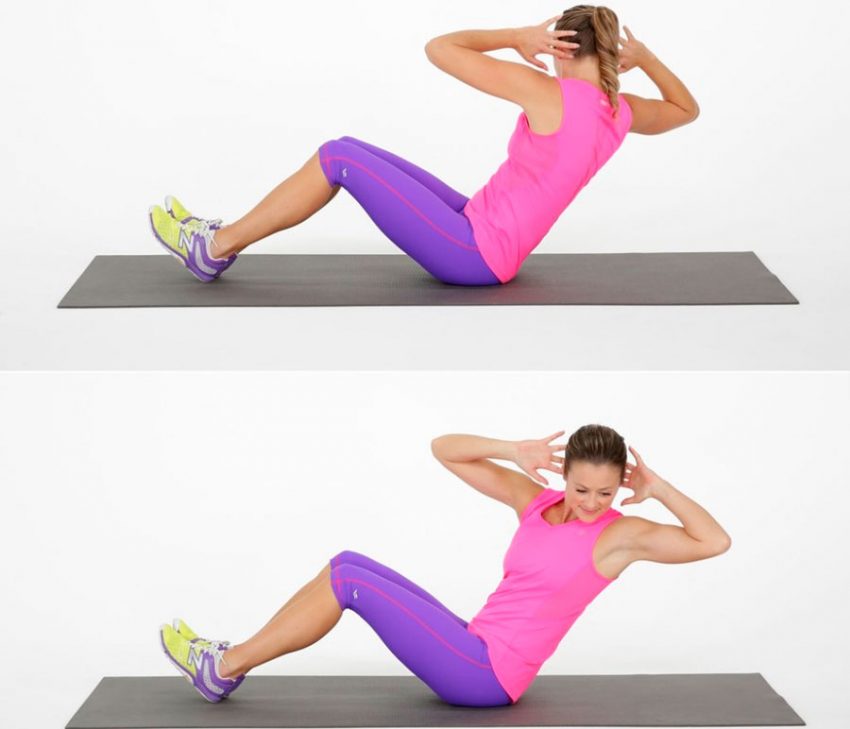Twisting with a twist of the body is one of the basic exercises for the press. It involves not only the straight and oblique, but if done correctly, also the transverse abdominal muscle. The exercise is suitable for everyone who wants to pump up the press, even those who practice at home, because it does not require specialized equipment to perform. You can do it on a bench, but it is completely unnecessary.
The exercise came to us from gymnastics, where it is performed with a slight technical nuance. With each repetition, the athlete contracts the press more and more, pushes the abdominal wall inward and rises above the floor.
Execution technique

- Starting position as for a straight twist – lie on the floor or on a bench, put your heels 10 cm from the buttocks, pull in your stomach, and press your back to the floor;
- As you exhale, lift your back off the floor as in a straight twist;
- At the top point, hold for 1-2 seconds and inhale, and then bring your right shoulder to the left knee;
- Exhale, again linger in the oblique twisting position;
- Take a neutral position while inhaling;
- Do the exercise in the opposite direction;
- Lower your back to the floor, do the required number of repetitions.
Recommendations for implementation
- Use the abdominal muscles throughout the movement, do not “throw” the body down and do not fall to the floor by inertia;
- Try to train so that every movement, muscle contraction, tension is conscious, do not perform the exercise mechanically;
- Do not rest your chin on your chest or work your neck;
- If it is difficult to understand the mechanics of movement in the prone position, work out the exercise while standing, first twisting it obliquely;
- Tighten the transverse abdominal muscle, pulling in the abdomen;
- Try not to lift your lower back off the floor;
- Breathe slowly, this exercise is not intended for speed work at all;
- Keep your pelvis in one position, try not to tilt it from side to side.
Note

Often this exercise is done in combination with straight crunches on the press, but for beginners this is not entirely true. A more complex coordination exercise should be done at the beginning, that is, this twisting option is better to be done as the first exercise of a press workout.
In general, if an athlete’s workout consists of more than just abs and cardio, you can do just this exercise. Variations are the curl with the raised legs, the curl while standing, lying, and the curl on the incline and straight bench.
This exercise can be performed on a block, twisting while standing obliquely.
Abs workout should not be too long, it is enough to perform the exercise in 3-4 sets in the amount of 10-12 repetitions.
The load progression looks like this. First, they learn to draw in the stomach and bring the shoulder to the opposite pelvic bone while standing, then they perform the exercise lying down, the heels at a distance of 10 cm from the buttocks, after that they learn to do the exercise with the heels torn off the floor, and the legs raised to the “shins parallel to the floor” position.
The exercise can be included in strength training 3 times a week, or you can do it only once a week, on the other two days concentrating on other types of crunches.
Errors

- Pushing the abdominal wall forward;
- Swing shoulder to hip and lift by inertia;
- Holding your breath while twisting and lowering the body;
- Displacement of the pelvis from side to side;
- Neck work all over the range
- Efficiency tips
- Remember that the main movement here is not twisting to the side, but lifting the body forward while pulling in the abdomen. If this movement is absent, the athlete will simply over-strain the oblique muscles and neck;
- The lower back must be pressed to the floor, it should not be bent up;
- The tension of the press is kept consciously, that is, the athlete should not let go of mental concentration;
- This seemingly simple exercise can be made more difficult by reaching with your shoulder to your thigh, really pulling in your abdomen, rather than relaxing your anterior abdominal wall.
Exercise is contraindicated in pregnancy, diseases of the spine, including hernias and protrusions, as well as in disorders of the hip joints. Temporarily cancel the movement with intercostal neuralgia.
As for the popular “horror story” about the growth of the waist from this exercise, it has nothing to do with reality.
